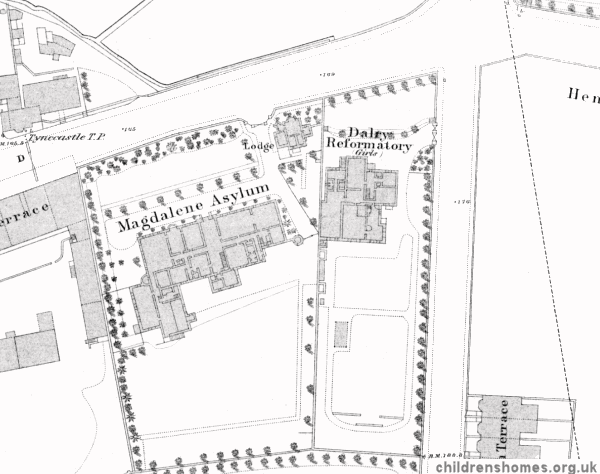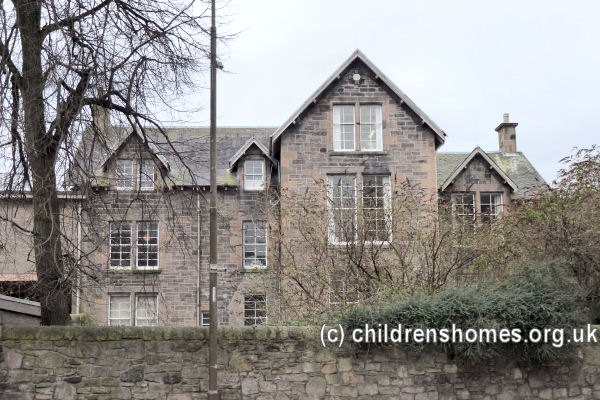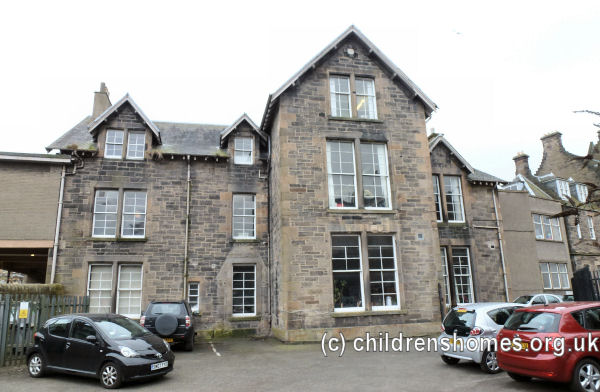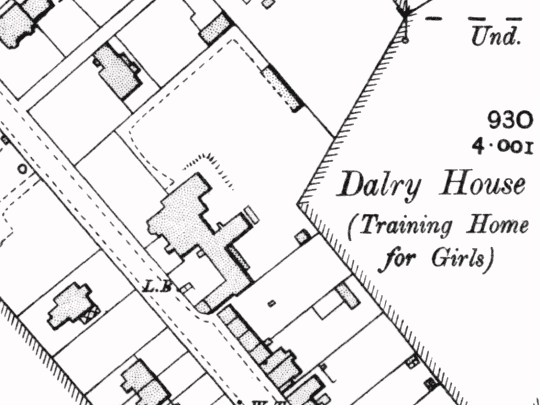Reformatory for Girls, Edinburgh, Midlothian, Scotland
In around 1848, a branch of the Dean Bank Institution for the Reformation of Female Juvenile Delinquents was opened at Boroughmuirhead, Morningside, Edinburgh. Its aim was the reform of girls and young women who had been been discharged from prison. Amongst their various sources of income, the two institutions received an annual grant from local police funds.
On 23 April 1858, the Boroughmuirhead institution was certified to operate as a Reformatory School with accomodation for up to 20 girls placed under detention by the courts. An inspection in November of that year noted that the premises consisted of a small house, with out-buildings used a laundry, and a yard for exercise. The arrangements were described as all being cheap and plain. The matron of the establishment ws Mrs Hutton.
After ownership of the property changed hands in 1859, the school was forced to seek new premises. After failing to find a suitable property, it was decided to erect a new building for the purpose. A suitable site was found on Dalry Road, Edinburgh, and plans commissioned from Mr R. Paterson. The new building was described as a neat and substantial house of three storeys. It was surrounded by a boundary wall which enclosed three-quarters of an acre of land, partly laid out as a garden and partly as a bleaching-green and playground. The interior included three large halls, about 40 feet by 16 feet, one above the other,extending across the whole width of the house. The lowest, on the ground floor, was the school room, while the two upper ones were dormitories, each supplied with twenty single bedsteads arranged in two rows along the room. In addition, the facilities included cooking and washing rooms, laundry, sick-room, and apartmenst for the matron and teacher. The cost of the building was about £1000 but considerable extra expense was incurred connectng pipes to the nearest branch of the city's mains water supply. The premises received their certificate to begin operation on 5 November 1861, with the formal opening taking place on 21 November. The house could accommodate 40 girls in total, with the 28 existing inmates at Broughmuirfield being received initially.
By 1862, the matron was Miss Ellen Whiteford, formerly employed at the Dean Bank Institution. Her sister, Miss Margaret Whiteford, assisted with the school teaching at Dalry.
The 1863 inspection recorded that there were upwards of 40 girls under sentence at the school, many of them almost young women in years and stature, having been received at an older age than in most other reformatories. The industrial occupations largely consisted on needle, house and laundry work. The laundry had been enlarged to make better provision for the latter. The girls' reading and writing from dictation were noted as being far superior to what the inspector had found in the majority of such institutions.
The premises were extended in 1865 by the addition of a new schoolroom, additional dormitories and a bathroom. A sick-room was also being provided.
The school site is shown on the 1878 map below.

Dalry Reformatory for Girls site, Edinburgh, c.1878.

Former Dalry Reformatory for Girls, Edinburgh, 2013. © Peter Higginbotham

Former Dalry Reformatory for Girls, Edinburgh, 2013. © Peter Higginbotham
In 1868, Miss Margaret Whiteford gave up her post as schoolmistress owing to ill health. She was succeeded by Miss McIntosh. A much larger playground and drying ground had been constructed at the south side of the school.
In 1874, the laundry was further enlarged, and more space provided in the schoolroom.
In 1877-78, Miss Whiteford's ill-health compelled her to give up her duties for a period. During her absence, while a temporary superintendent took charge, several of the older girls gave a great deal of trouble. There were several cases of absconding and four girls were sent for terms of imprisonment.
In 1882, an outdoor playshed, measuring 50 feet by 18 feet, was erected so that the girls could take exercise under cover, even in bad weather. The laundry continued as the main industrial occupation for the older inmates, while all the girls received instruction in knitting and needlework and made their own clothing. The girls helped in the kitchen and did all the housework. Some of the older girls went out for day-service in respectable families as a test of their training. A mark system was in operation, the penalty for misconduct being a forfeiture of good marks and privileges.
Her declining health led to Miss Whiteford's departure in March 1886. She was succeeded as matron by Miss Thomas.
The inspection in 1890 recorded only 25 girls at the school. A gradual decline in numbers being placed at the school was attributed to the objection by magistrates to the short period in prison that was required at the start of Reformatory School sentences. The reduced number of inmates resulted in the scale of the laundry operation, a valuable source of income to the school, being curtailed.
In 1893, Miss Carter succeeded Miss Thomas as matron. As was often the case, the change resulted in many cases of rude conduct, disobedience, insubordination and restlessness, and several girls absconded. It also transpired that the staff had not been working harmoniously together. The girls were punished, some changes took place in the staff, after which good order was resumed.
More problems occurred in February 1896 when six girls absconded. All were brought back, and one was subsequently transferred to another reformatory. Three others from the same group absconded again the following month, and were brought back the same night. There was also an attempt to set fire to the washroom. In June, a number of the girls absconded when taken out for a walk, and their conduct was such that several of them were sent to prison by the magistrates. Miss Carter left later in the year and was succeeded by Miss P.A. Camp. She in turn was replaced by Mrs Macrae in November 1897.
The school premises were the subject of growing criticism by the inspector. They were dark and many parts were in need of repair. The location was becoming increasingly built up. It also placed many of the girls in close proximity to their friends. On one occasion, an Edinburgh 'gaol-bird' attempted to break into the school at 2.30am one Sunday morning in order to contact his sister. Consequently, the school's managers resolved to remove the establishment to a new location.
The school transferred to its new home in 1899. The new premises were at Hawthorn Gardens, Loanhead, about five miles to the south of Edinburgh. The property, a former private house with a large garden to its rear, were formally certified for operation on 22 May 1899, with accommodation for 68 girls, below the age of 15 at their date of admission. The institution now became known as Dalry House Training School, with Mrs Macrae continuing as matron.
The School site is shown on the 1907 map below.

Dalry Reformatory for Girls site, Loanhead, c.1907.
An inspection of the school in 1901 rated classroom performance in singing, recitation and composition as 'good', while mental arithmetic and geography were 'very fair'. History had received attention and object lessons had been given. The principal industrial training was in laundry, together with plain sewing and knitting, a little fancy work and house work. A cookery class for the older girls was held on Saturday afternoons. Regular drill and exercises to music were given and walks were taken in the countryside twice a week in the summer. There had been several treats and picnics and several entertainments had been visited. Dancing was allowed on Saturday evenings.
Mrs Macrae left on 4 December 1906 and was succeeded by Miss Barbara Murray, formerly the school's laundry matron. At the 1907 inspection, the girls went through some Swedish exercises. They had also been taught some Swedish games and played games such as croquet out of doors. During the year, three well-behaved girls were allowed to go home for a few days, their homes being respectable.
Following Miss Murray's death in September 1907, Miss Jessie Mackay became matron. Like Miss Murray, she had previously been laundry matron. Miss Mackay resigned in October 1910, after which considerable unrest took place for a period. Miss Mackay was succeeded the following February by Miss Margaret Pearne. In the interim, the former matron, Mrs Macrae, returned to take charge of the school. A mark system was introduced carrying money awards and good conduct stripes.
On 13 January 1922, following a steady decline in the number of girls being placed at the school, its managers announced their intention to resign their certificate.
In 1924, the Loanhead premises were acquired by the Church of Scotland and was used as a residential home for girls before becoming an old people's home in 1932. Mayburn house as it became known, continued in operation until 2008.
Records
Note: many repositories impose a closure period of up to 100 years for records identifying individuals. Before travelling a long distance, always check that the records you want to consult will be available.
- None identfied at present — any information welcome.
Census
Bibliography
- Carpenter, Mary Reformatory Schools, for the Children of the Perishing and Dangerous Classes, and for Juvenile Offenders (1851, General Books; various reprints available)
- Carlebach, Julius Caring for Children in Trouble (1970, Routledge & Kegan Paul)
- Higginbotham, Peter Children's Homes: A History of Institutional Care for Britain's Young (2017, Pen & Sword)
- Abel Smith, Doroth Crouchfield: A History of the Herts Training School 1857-1982 (2008, Able Publishing)
- Garnett, Emmeline Juvenile offenders in Victorian Lancashire: W J Garnnett and the Bleasdale Reformatory (2008, Regional Heritage Centre, Lancaster University)
- Hicks, J.D. The Yorkshire Catholic Reformatory, Market Weighton (1996, East Yorkshire Local History Society)
- Slocombe, Ivor Wiltshire Reformatory for Boys, Warminster, 1856-1924 (2005, Hobnob Press)
- Duckworth, J.S. The Hardwicke Reformatory School, Gloucestershire (in Transactions of the Bristol and Gloucestershire Archaeological Society, 1995, Vol. 113, 151-165)
Links
- Red Lodge Museum, Bristol — a former girls' reformatory.
Except where indicated, this page () © Peter Higginbotham. Contents may not be reproduced without permission.


